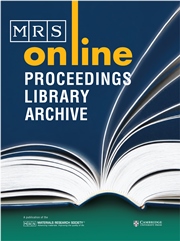Article contents
Grain Boundary Corrosion and Alteration Phase Formation Duringthe Oxidative Dissolution of UO2 Pellets
Published online by Cambridge University Press: 03 September 2012
Abstract
The alteration behavior of UO2 pellets following their reactionunder unsaturated drip-test conditions, at 90°C, for time periods of up to10 years has been examined by solid phase and leachate analyses. Samplereactions were characterized by preferential dissolution of grain boundariesbetween the original press-sintered UO2 granules comprising thesamples, development of a polygonal network of open channels along theintergrain boundaries, and spallation of surface granules that had undergonesevere grain boundary corrosion. The development of a dense mat ofalteration phases after two years of reaction trapped loose granules,resulting in reduced rates of particulate uranium release. The parageneticsequence of alteration phases that formed on the present samples was similarto that observed in surficial weathering zones of natural uraninite (UO2) deposits, with alkali and alkaline earth uranylsilicates representing the long-term solubility-limiting phases for uraniumin both systems.
Information
- Type
- Research Article
- Information
- Copyright
- Copyright © Materials Research Society 1997
References
REFERENCES
- 8
- Cited by

